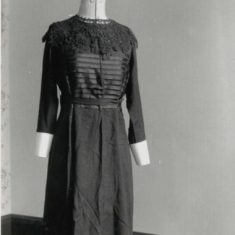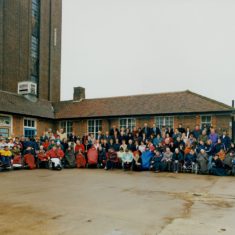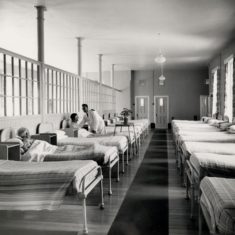Out of Sight?
Trestle Performance
By Catherine Davis
I thought I’d be impressed by The ‘Out of Sight, Out of Mind?’ performance because the power of the stories allied to Trestle’s skills seemed like a great combination. However I hadn’t anticipated just how good the event would be, or how the Trestle Arts Base, the old Hill End Hospital chapel would turn into a time machine carrying us through the stories of the patients, staff and soldiers over the last 100 years or so.
I arrived at Trestle on a sunny Saturday afternoon about 15 minutes before the performance was due to begin and went into the marquee to chat to with other members of the audience including Bernard Lloyd, the new HCC Chairman and colleagues from St Albans Council. Outside a 1940s nurse was sipping her tea from an enamel mug, at least I assumed it was tea. She began to tell us about her working life in the hospital and how fond she was of one or two of the patients. Suddenly a siren sounded which sent shivers down my spine and we were urged to move on by another very bossy nurse, with a clipboard, to ‘hurry along now’ into the main building.
Pale faces and birds nest hair
We passed into the building’s lobby and were brought up short by a 19th century lady sitting singing and knitting with red wool (a recurrent thread in both the performance and the setting). Above her on the upper floors stood the patients with pale faces and birds nest hair dressed in their nightclothes, whispering and pointing, while the staff with much harsher more inscrutable faces looked on.
Victorian Ophelia
The Victorian Ophelia, surrounded with flowers and grass, told us her story. At times lucid, at others confused and disjointed, she related how she had had a child but had been abandoned by her lover and the child had died. Or at least that was what I understood her story to be as her narrative slipped back and forth through time as well. She had just finished her tale when a man came rushing in from behind us pursued by a train. He could hear it and smell it, the smoke and steam and just had to keep on moving or it would catch him. No sooner had he told us this, than he, in his 1950s dressing gown, vanished pursued by the imaginary Leviathan.
An odd place out of time
We were just catching our breaths when the glass lift quietly descended with a single woman inside. As it came to a stop half way down she tapped at the glass and begged us to let her out as she shouldn’t be there. There was nothing wrong with her and please could we let her out. While all this was going on all the other patients looked on to see our reactions. Just like the old mental hospitals, the setting had absorbed us and taken us to an odd place out of time and one, in which it isn’t entirely clear who was ill and who wasn’t. It was very strange to experience that feeling again in the modern setting of an arts venue but the building’s older memories seemed to be stirring.
Leaves and suitcases
We were again urged on by the bossy nurse and left the poor lady suspended while we passed into another room filled with leaves and suitcases. At this point we met the children’s theatre group. They came in as their curious selves and then transmogrified, through the contents of the suitcases, into staff members or patients who were on the point of being admitted. One girl was stopped and asked where she was going and could they see her name tag so she could be returned to her ward. She told them she was looking for her mother who was patient, but neither we nor the staff entirely believed her. Again resonances of mental hospitals fictional and real, where the well were detained, flitted though one’s mind, from Maggie O’Farrell to modern China and back to scene in front of us. Fortunately the girl was recognised by one of the staff, but only because her mother, who was indeed a patient, had once been a nurse at Hill End alongside them.
The bossy nurse, who was by this time, was beginning to remind me more and more of the White Rabbit, returned. We were now being urged to climb the stairs to the next floor. As we passed up the stairs the patients whispered their stories at us. We filed into the early 1940s and saw a family bid farewell to the father going off to war. This took place in the Trestle boardroom which was hung about with vintage clothing on threads. From there were ushered to the window (which would have been the great window behind the chapel’s altar) to look out and see the soldiers below perform dance like movements which led from fighting to injury and collapse to eventual assistance from the nurses who led them tenderly away. This was again performed by the children and young people. Then as we turned away from that sight it was to be chivvied out, passing the staff from St Bart’s on their way in. They were evacuated to Hill End during the war and treated wounded soldiers there.
‘Wild of dress and sullen of countenance’
We left them to their efficient checking of equipment while we carried on up to the next floor. As we went the Hill End nurses looked us up and down and commented for their notes upon our state both physical and mental. I was pronounced ‘wild of dress’ and ‘sullen of countenance’. As ever I suspect the first remark was not entirely unmerited. However as I smiled about it the second, much less accurate remark, was made and it made me consider whether past patients had had such standard remarks applied to them in the early days of the institution which hadn’t really borne much relation to reality either. Behind the actors, the red wool was running in great spiders’ webs up and down the stairs and its rather harsh red struck another discordant and unsettling note.
Experiences at Hill End
After our assessment we filed onto the top balcony and looked down and listened while two patients read alternately of their experiences at Hill End. I thought that the accounts were perhaps from different periods, the 1930s and the 1960s say. (As an aside I later asked Oliver Jones about this and he told me the accounts from the 1960s and 1970s. The author of one of them was in the audience and I realised she was bit older than me).
Claustrophobic and unsettling
We were then ushered along the corridor into a room set up as a sitting room of about the late 50s or 1960s. Before that we met the man who was anxious about trains standing at the end of the corridor surrounded by steam (well dry ice) which looked amazing visually and again I felt that I’d glimpsed into a strange funfair or a parallel world. As we were now at the top of the building in quite a narrow corridor it felt claustrophobic and unsettling.
Red wool
The day room came as welcome piece of normality. However the young man of 17 who spoke to us felt like he was made of glass and although he thought he was getting better you could tell he was likely to be there a long time while his youth slipped away. He was there with three women knitting in the ever present red wool. This was a very funny but very moving section of the performance. I was particularly struck by how all the patients didn’t think they were the ones who were ill and that they were wrongly being held in the hospital. They each individually complained about being shut up with other old people and not wanting to waste their lives there. At times they seemed very lucid, while at others an odd strangeness would appear which gave an insight both into them and into the working lives of the staff that had to look after them. This attitude echoed an earlier reference that had been made to the fact everyone had their cases packed ready to leave at a moments notice, whether they were there in the short or long term. Suitcases, like the red wool, were ever present in the production. That self awareness about the waste of their lives brought me up short because I’d always thought for those who were ill the involvement and severity of their illness, and its absorption of their time, would somehow shield them from the knowledge of life passing with little to show for it in society’s terms. I’d completely missed the point that at times when they were well that knowledge would be all too sharp.
Not all bleak
However all was not bleak as humour bubbled up throughout the whole of this piece, although its hue was often black. The dayroom session was also enlivened by a previously mentioned lady who refused to wear knickers and she then departed pursued by a nurse who was urged on to make sure she put them on, by our ever present medical mistress of ceremonies. The thoughts of ‘exit pursued by bear’ flitted though my mind.
Opium, laudanum, Valium, Prozac
As we left the day room we met the again the nurse who had begun the whole story, in what seemed like a very long time ago. This time the enamel mug had something stronger than tea in as she recited all the things people have taken to dull pain ‘opium, laudanum, Valium, Prozac….’ To the background buzz of hers and other comments we passed down another staircase. On each of the landings hung a suitcase filled with photos, clothes, shoes or other possessions of the patients or staff that had lived there. They were worth a long look in their own right, but there was not time as we hurried down the staircase to be sat in front of the double doors at the back of the building. They opened and we saw the wounded soldiers being led into the hospital each leaning on a nurse or two as they staggered past. One of the Hill End nurses was heard to comment ‘we thought we’d seen everything here but we’ve never seen that’ Presumably while the occasional patient who thought they could fly, and died trying to prove it, or those who injured themselves because of their illness were part and parcel of their working life severely injured men from battlefields still came as a terrible shock.
The sound of music
The doors slowly closed and the sound of music could be heard coming from a nearby room (this was the theatre in the building). We trailed in to be met by the sight of the hospital orchestra. As we entered the room we were each directed to sit round a metal hospital bed of a fairly old design. The orchestra left and instead we found ourselves sitting in a female patients ward as they readied themselves for bed. Each actress made her way to one of the beds and stood on it to tell us more about their communal life there and how they related to one another as a group. Their stories were followed by two nurses. One was our old friend with the enamel mug. She told us about her one day off a month that she was allowed to leave the hospital but to travel no more than 10 miles away. She visited the park and there she spoke to man. The other nurse tried to be kind to the patients and to do her best for them; not least she tried to make sure they got their own teeth each day. Some of her kindness was a ‘there but for the grace of God go I’ reaction. Breaking the rules, she had had a relationship with a member of the male staff and had become pregnant. She’d lost the baby before the authorities found out. Presumably she all too well acquainted with other women who had been committed to such hospitals by their families for a similar transgression.
Dolls
As the nurses finished their tales and the left then all patients began to speak at once. I was at by a girl who clutched and then discarded her dolls and begged us not to look at her or touch her. I found myself wanting to hold and soothe her, but found that I sat there with lowered my eyes because her distress was all too real and I didn’t want to add to it. Once again that feeling of being lost in another place out of time had been brought to life. I was reminded of when I’d visited staff working in the library at Fairfield Hospital in Bedfordshire in the final years before its closure. Like Hill End it was on a large isolated site and the main building had long concrete corridors that had you lost pretty much as soon as you stepped into them. The world beyond the looking glass always seemed to apply there as well.
Locked in
Once the tales were told they left us for the last time and we the guests were left sitting around empty beds in the semi darkness. The large doors shut for a final time as we all sat in silence while the rattling sound of the key and its chain echoed through the room as we were locked in for the night.
A marriage of drama, history, people and place
After much applause for the ensemble cast we filed out of the building back into a sunny afternoon in July 2009. On the steps and out into the grounds were pairs of shoes running off into the distance. I thought it was a fantastic production with a wonderful cast. I found it very hard to believe that the disparate elements of the cast had only been brought together the previous Wednesday to put all the production together. I just wish that more people had been able to see such a great marriage of drama, history, people and place. Several of the cast members I know via work Natalie Fountain from the University and Katherine Holt an artist who’d I’d been discussing a lottery application with a couple of weeks before. Yet as a patient and the enamel mug nurse respectively they were entirely believable. I think it will be a long time before I see another piece of drama which was quite so memorable and moving.






Add your comment about this page